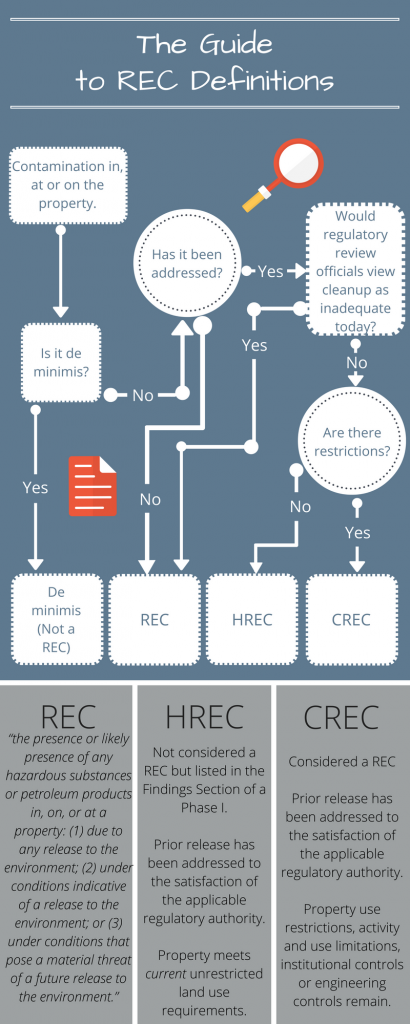ASTM last updated the Phase I ESA E1527-13 in 2013, yet questions remain about how environmental professionals should be applying the new suite of REC definitions in practice. In response to client questions about the differences between a REC, HREC and CREC under E1527-13, LightBox EDR® prepared this guide.
What is a “recognized environmental condition” or REC?
Definition “the presence or likely presence of any hazardous substances or petroleum products in, on, or at a property: (1) due to any release to the environment; (2) under conditions indicative of a release to the environment; or (3) under conditions that pose a material threat of a future release to the environment.”
What is a “Historical REC” or HREC?
Definition: “a past release of any hazardous substances or petroleum products that has occurred in connection with the property and has been addressed to the satisfaction of the applicable regulatory authority or meeting unrestricted use criteria established by a regulatory authority, without subjecting the property to any required controls (e.g., property use restrictions, AULs, institutional controls, or engineering controls). Before calling the past release an HREC, the EP must determine whether the past release is a REC at the time the Phase I ESA is conducted (e.g., if there has been a change in the regulatory criteria).”
The determination of an HREC is intended to be used for properties that would have previously been determined a REC, but that have undergone remediation of risk-based cleanup. These sites are not subject to any known restricted land use requirements. In addition, the Environmental Professional (EP) must also verify that no changes have taken place, such as updates to the cleanup standards that would deem the release a REC today.
In our Technical Brief: What is a CREC and How is it Determined?, Attorney and Task Group Member, William Weissman explained:
“For the user community, whether on the buyer or seller side of a transaction, they need to know whether remedial activities at the property result in a changed status at the time of the Phase I assessment. Thus, defining an HREC requires a two-step analysis:
(1) Did the remediation result in a condition that meets unrestricted residential use? and
(2) Has there been a change in regulatory policy so that at the time of the Phase I assessment the site would no longer meet unrestricted residential use?”
What is a “controlled REC” or CREC?
Definition: “a REC resulting from a past release of hazardous substances or petroleum products that has been addressed to the satisfaction of the applicable regulatory authority (e.g., as evidenced by the issuance of a NFA letter or equivalent, or meeting risk-based criteria established by regulatory authority), with hazardous substances or petroleum products allowed to remain in place subject to the implementation of required controls (e.g., property use restrictions, AULs, institutional controls, or engineering controls)… a CREC shall be listed in the Findings Section of the Phase I ESA report, and as a REC in the Conclusions Section of the…report.”
The term CREC, or “Controlled REC” refers to a REC with past releases that have been addressed, but where contamination still remains and is subject to the implementation of required activity use limitations (AULs) such as institutional or engineering controls. While HRECs must be listed in the findings section, CRECs are considered RECs and must be listed in the findings section as a REC and in the conclusion. While CRECs and HRECs both apply to target properties with previous contamination, sites with HRECs currently have no restrictions and thus do not need to be listed as a REC.
In an article written by Nick Albergo, the Vice Chair of the Environmental Assessment, Risk Management and Corrective Action ASTM E50.02 Committee, he clarifies, “The CREC determination now captures the continuum of scenarios that were susceptible in the past to misinterpretation by Users, including self-directed cleanups that embrace risk-based closures or the establishment of alternative site cleanup target levels, other cleanups signed off by the regulator but without referencing a formal control (i.e., AUL), petroleum cleanups that rely on natural degradation (e.g., Low-Scored Site Initiative (LSSI NFAs), and other instances where contaminants remain in place and may still pose existing or future challenges to site redevelopment and/or valuation (e.g., low score dry-cleaning sites where significant soil contamination and vapor remains).
Examples:
The following examples were the consensus of consultants participating at last year’s Due Diligence at Dawn tour.
Example 1:
Your target property site is a shopping center and has been remediated by removing the source of contamination and contaminated soil. However, the groundwater (GW) remains contaminated. The state agency in applying Risk Based Corrective Action (RBCA) is allowing the contamination in the groundwater to attenuate naturally but requires quarterly GW sampling. REC/HREC/CREC?
GW contamination on site would normally constitute a REC, but having the state agency allow natural attenuation under RBCA, most consultants would view this as a CREC.
Example 2:
You are currently conducting a Phase I on a shopping center that was remediated ten years ago using risk based cleanup. The state agency approved closure and issued an NFA letter at the time. However, it has been determined that the vapor pathway was not considered when the risk-based cleanup took place.
Because contamination still remains on the property and a risk based cleanup took place without considering the vapor pathway, and since the site can no longer meet unrestricted residential use, most consultants would view this as a REC.
Example 3:
Your target property is an office complex that has been remediated to industrial/commercial soil and GW standards. An NFA letter has been issued. REC, HREC, CREC?
Most consultants would view this as a CREC! Contamination still exists on the property above residential remediation standards, but below the industrial/commercial standards. The NFA letter issued by the state has an inferred restriction that the property remain industrial/commercial.
Example 4:
Your target property was previous cleaned up to industrial standards (and is zoned industrial) and issued an NFA letter. REC/CREC/HREC?
Most consultants would view this as a CREC. The criteria of “unrestricted use” is not met in this scenario. The zoning prohibits residential use so even though cleanup was completed to the satisfaction of the state agency and an NFA was issued, a restriction does exist.
Example 5:
A LUST on a multifamily property has been remediated by excavating and disposing of the UST along with the contaminated soil, and the groundwater has been remediated to residential cleanup standards. The state has issued a NFA letter. REC, CREC, HREC?
Most consultants would view this as a HREC. Contamination on the property meets residential cleanup standards and there are no restrictions, stated or implied, in the NFA letter issued.

